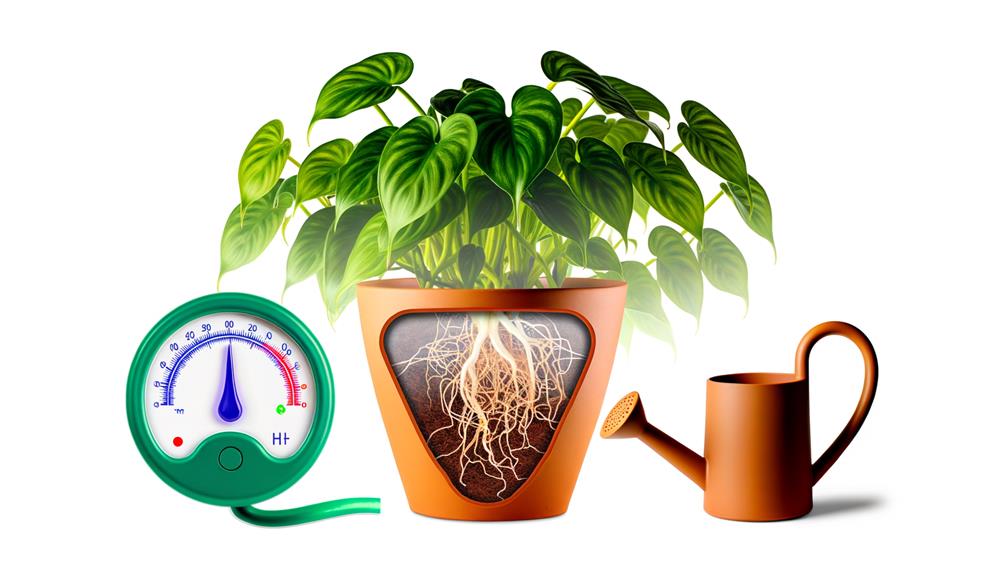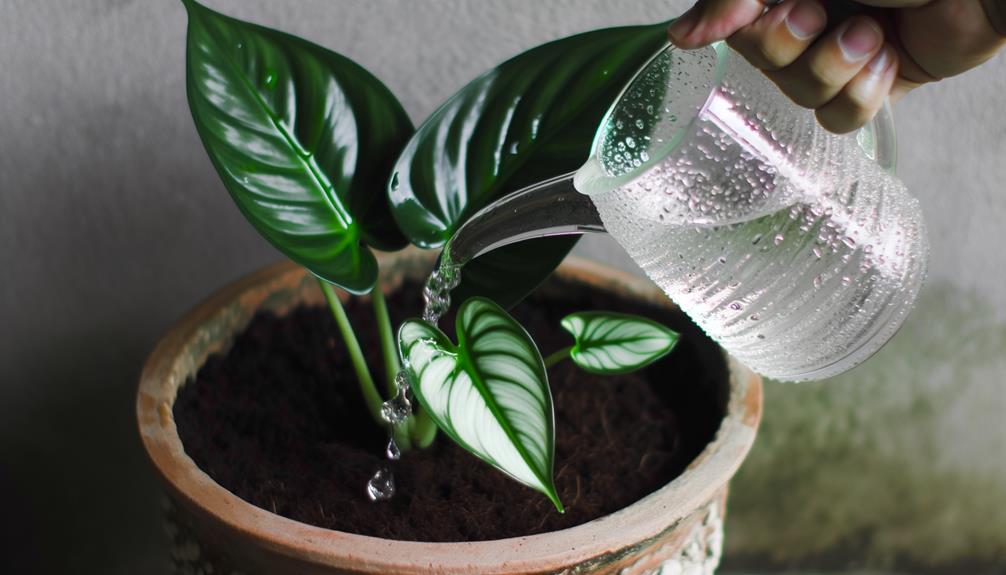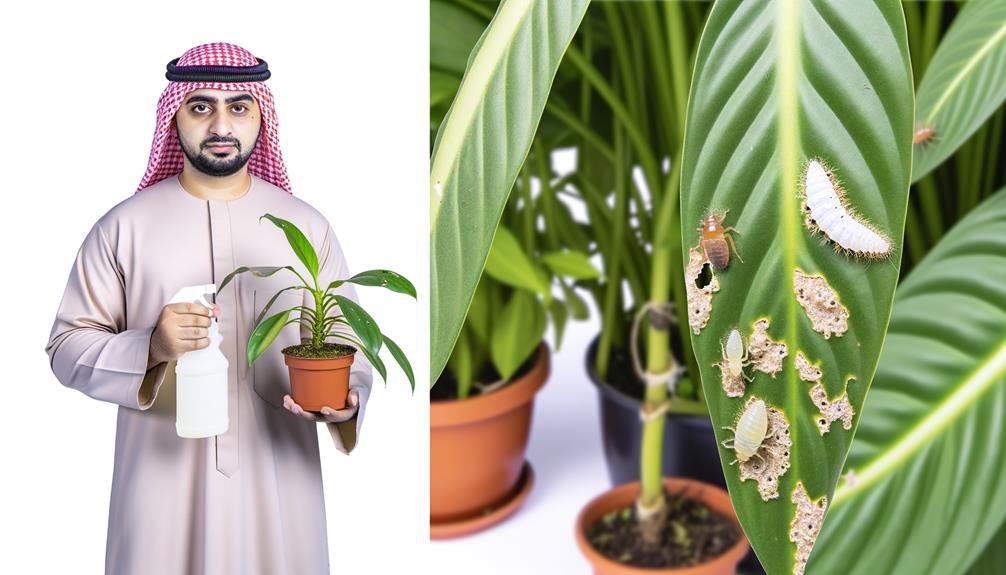White Wizard Philodendron Care
White Wizard Philodendron, a respected Araceae cultivar, requires specific care for proper growth and foliage health. This includes appropriate lighting—medium to bright indirect light enhances growth, while preventing leggy stems and leaf burns.
Watering should be moderate, allowing the top soil inch to dry between sessions. Regular feeding with a balanced, water-soluble fertilizer aids in robust foliage and root development.
Pests such as aphids, mealybugs, and spider mites should be managed through regular inspection and appropriate treatments. To ensure your plant's essential health, further information on these critical care aspects is available.

Key Takeaways
- White Wizard Philodendrons thrive in medium to bright indirect light, but can adapt to lower light conditions.
- Avoid both overwatering and underwatering; allow the top inch of soil to dry before watering again, typically every 1-2 weeks.
- Fertilize every 6-8 weeks during the growing season with a balanced, water-soluble fertilizer like a 20-20-20 blend.
- Rinse soil thoroughly when fertilizing to prevent mineral salt buildup, especially important during winter months.
- Regularly inspect for common pests such as aphids, mealybugs, and spider mites; treat with beneficial insects or insecticidal soap/neem oil.
Understanding White Wizard Philodendron

The White Wizard Philodendron, a popular cultivar of the Araceae family, is an intriguing plant species renowned for its striking, white-variegated foliage and its adaptability to indoor environments. This tropical plant is native to South America and thrives in humid, warm conditions.
Its distinctive foliage, featuring large, heart-shaped leaves with unique white variegation, contributes to its aesthetic appeal. The plant's adaptability to low-light conditions and resistance to common plant diseases make it a desirable choice for indoor gardening.
However, like any plant species, the White Wizard Philodendron requires specific care to maintain its health and promote growth. Understanding its natural habitat, growth habits, and particular needs is essential for those who desire to nurture this exotic plant successfully.
Proper Lighting Conditions
Understanding the White Wizard Philodendron's affinity for light is a fundamental aspect of its care, as it directly correlates to its growth and overall health. This species thrives in medium to bright indirect light but can adapt to low light conditions. However, too little light may inhibit growth and lead to leggy stems, while too much direct sunlight can cause leaf burn.
Here is a table summarizing the ideal lighting conditions:
| Light Intensity | Suitable for Growth | Potential Problems |
|---|---|---|
| Low Light | No | Inhibits growth, leggy stems |
| Medium Light | Yes | Optimum condition for growth |
| High Direct Light | No | Can cause leaf burn |
Watering Your Philodendron

Mastering the balance of moisture for your White Wizard Philodendron is crucial to its successful cultivation. Overwatering and underwatering each present unique challenges to the plant's health. Overwatering can lead to root rot, a fungal disease that hinders nutrient absorption. Underwatering, on the other hand, can cause leaf curling and wilting due to insufficient hydration.
Research indicates that this plant prefers consistent, moderate watering. It is recommended to allow the top inch of soil to dry out between waterings. In average indoor conditions, this typically translates to watering once every 1-2 weeks. However, this frequency may need to be adjusted based on environmental factors such as light intensity and humidity.
Utilizing a moisture meter can help ensure ideal watering practices, promoting plant health and longevity.
Feeding and Fertilizing Needs
Feeding your White Wizard Philodendron with the appropriate nutrients greatly contributes to its overall health and vibrancy, necessitating a thorough understanding of its specific fertilizer requirements.
This plant thrives when fertilized every six to eight weeks during the growing season with a balanced, water-soluble fertilizer such as a 20-20-20 blend. This ratio guarantees an adequate supply of nitrogen, phosphorus, and potassium, essential for robust foliage, strong root development, and overall growth.
During winter months, it is advisable to reduce the frequency, as the plant's metabolic processes slow down. Over-fertilization can lead to a buildup of mineral salts, causing leaf burn. It is of great importance to rinse the soil thoroughly every few months to prevent such accumulation.
Dealing With Common Pests

Despite the White Wizard Philodendron's overall resilience, it is not immune to common pests such as aphids, mealybugs, and spider mites, which can pose significant threats to its health and longevity.
These pests can feed on the plant's sap, leading to yellowing, wilting, and slower growth. To manage these pests, regular visual inspection is essential. Aphids are usually found on the undersides of leaves, while mealybugs appear as cottony masses on stems and leaves. Spider mites, though tiny, can be detected by the fine webs they spin.
Biological control methods, such as introducing beneficial insects that prey on these pests, can be employed. Alternatively, a mild insecticidal soap or neem oil can be applied to infested plants to eliminate pests without damaging the plant.
Conclusion
To conclude, the care of the White Wizard Philodendron, a distinctive addition to any plant collection, necessitates a deep comprehension of its lighting, watering, feeding, and pest control requirements.
Peak plant health can be attained through meticulous observation of these essential factors. The application of these guidelines guarantees the flourishing growth of this splendid plant and enhances the overall beauty of its surrounding environment.
The White Wizard Philodendron truly showcases the wonder of botanical diversity.






